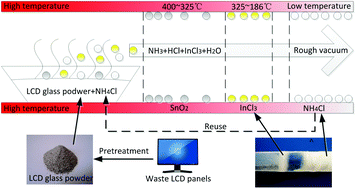In this study, an efficient rough vacuum-chlorinated separation method was developed for the recovery of indium from waste liquid crystal display (LCD) panels using NH4Cl as the chlorinating agent. High purity In2O3 and SnO2 were firstly investigated in a rough vacuum, air and nitrogen atmosphere. The results indicated that the rough vacuum atmosphere could increase the recovery ratio of indium and reduce the influence of tin simultaneously. Moreover, the indium chloride and NH4Cl can be selectively recovered under different condensing temperatures, and the thermodynamic principle of the recovery method was analyzed. Conditions of 400 °C, 10 min, rough vacuum atmosphere (0.09 MPa) and sufficient NH4Cl (molar Cl/In ratio of 6) were confirmed as the optimal conditions by pure substance experiments. The waste LCD glass powder was used to recover indium. The weight ratio of NH4Cl to glass powder and the optimum particle size were confirmed as 1 : 2 and less than 0.13 mm, respectively. The pure indium chloride was successfully recovered from the waste LCD panels using this method, and the recovery percentage of indium and the purity of indium chloride are 98.02 and 99.50%, respectively. This work presented a promising technology for the cyclic regeneration of the precious metal indium from waste LCD panels.

You have access to this article
 Please wait while we load your content...
Something went wrong. Try again?
Please wait while we load your content...
Something went wrong. Try again?


 Please wait while we load your content...
Please wait while we load your content...